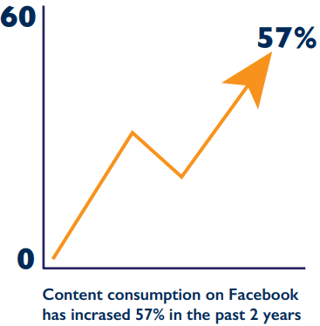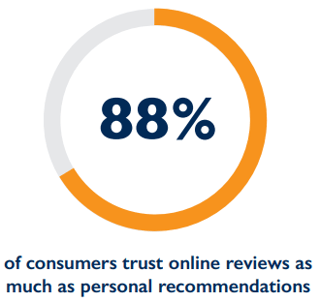
The total number of cosmetic procedures has increased over 6% in the last year, and over 730% in the last two decades. As technology advances, accessibility of your services increases and becomes an option to a variety of people. These people are researching the procedures they’re interested in, and will decide on who they feel most comfortable with.
This is a comprehensive guide on how to effectively market your plastic surgery practice in 2018 to capture the attention of the right people at the right time.
We know it's a lot of information, so feel free to bookmark this page or download it in the form of an eBook so you can refer back to it as you need so you can maximize your plastic surgery marketing strategy in 2018.
It has never been more important to be there for your prospects during their research. Instead of calling around to different practices, they’re turning to the internet to find answers to their questions. Your marketing efforts need to empower prospective patients to feel comfortable choosing you as their surgeon.
The following chapters will explain the importance of the following tactics:
We’ll touch on how all these tactics work together as well as provide examples for each. Your marketing needs a strategic approach to provide an exceptional brand experience for your patients. This experience needs to be consistent across all channels and devices so you can maintain a consistent reputation of comfort and trust wherever and whenever your prospects engage.
With the total number of surgical and non-surgical cosmetic procedures up over 730% in the last 20 years, it has never been more important to establish your position in the market. Your branding is everything. It’s your reputation and more importantly, your credibility. Consumers have more buying power than ever, and you need to ensure your messages are consistent across each marketing channel, and back up your mission statement.

A great way to communicate your brand’s purpose is to create and operate according to a mission statement. Whether it’s a promise to your patients or an internal culture code, it keeps your brand accountable and consistent.
A consistent brand has purpose. Whether you’re the best rhinoplasty specialist out there or focus on breast augmentation, your specific skills that prospects can’t get anywhere else is what establishes your competitive advantage. Integrating this with your branding from the outset allows you to easily connect with your audience.
Developing a strong mission statement will allow you to keep your brand messaging focused and consistent. Your mission statement must be centered around your patients. It should speak to their needs and be relatable in order for it to effectively grow your brand.
An exceptional brand experience is focused on solving your prospects’ problems.
You need to relate to prospects emotionally for your brand to mean something to them. When it comes to your messaging, you need to balance emotion and professionalism. No one wants to be sold, but everyone is looking for the right solution.
In order to be recognized as the right solution, you need to keep your marketing messages relatable. Keep it simple and avoid technical medical terms as it could intimidate your prospects. Keep it conversational by using second person language and personalize your marketing to give it relevance. When you relate to your prospects by addressing their concerns, you establish trust and comfort.
Keep it positive. Using phrases that target your prospect’s insecurities will likely drive them away faster than anything else. Instead, focus on the outcomes. Focus on how they want to feel. Words that invoke a positive emotional response include youthful, energy, natural beauty, and vibrant.

As technology advances and minimally-invasive techniques become more accessible, cosmetic enhancements are no longer reserved for the top 1%. It’s becoming more affordable to the average person and your messages need to relate to people of a wide variety of ages, demographics, and lifestyles.
Consumers are becoming more open to enhancing their appearance, and your messaging should empower them to feel comfortable doing so. Provide customer before and after pictures to show how you have helped people in similar situations. Not only will this showcase your services, but it will also show how your services made a positive impact on someone else’s life. Social proof is a powerful tool, and harnessing that power in your marketing is a great way to speak to your prospects on an emotional level.
The ultimate goal of your branding is to create a welcoming and non-judgmental atmosphere. While establishing exclusivity is a great way to increase brand equity, it can also convey a sense of arrogance that could come with detrimental consequences. Keep it simple, clean, and professional. Your branding needs to speak to the quality of your services and an organized visual structure will speak to your professionalism without excluding any of your prospects.
A decade ago, your prospect’s first impression was likely a phone call. Now, it’s all about your website. When people are interested in something, they turn to the wonder world of Google to find their answers. Does your website keep your visitors engaged enough to find the information they came for?
 Just like meeting someone new for the first time, your website is typically the first impression you make on your prospects and you only have a few seconds to grab their attention. The first 5 seconds someone is on your website, they’re determining the quality of the information and whether it’s going to help them solve their problem. If not, they’ll leave and find it somewhere else.
Just like meeting someone new for the first time, your website is typically the first impression you make on your prospects and you only have a few seconds to grab their attention. The first 5 seconds someone is on your website, they’re determining the quality of the information and whether it’s going to help them solve their problem. If not, they’ll leave and find it somewhere else.
To have a successful website as a plastic surgeon, your site must be:
Your website is your biggest digital asset, and the most important piece of content you’ll invest in. It’s what attracts prospects to your site and keeps them engaged once they get there. When developing your content, you must keep these questions in mind:
Dedicate a page on your website to each procedure you offer. This way, you’ll allow prospects to navigate straight to the information they’re looking for, as well as explore other options available to them.
A common mistake we see is cluttering a single page with information about the different procedures you offer. This increases the “friction” for users to find what they’re looking for. You want a smooth user experience. The shorter amount of time it takes for users to stop clicking around and engage with content the better.

If you offer a wide range of procedures, a great way to set up your content structure is by grouping similar procedures together. For example, listing minimally invasive procedures apart from surgical enhancements can help hesitant prospects research their options.
The structure of your navigation gives your prospects an overarching outline of what you do as a plastic surgeon. If you specialize in a certain type of procedure, make it apparent from the start. If you offer other products or services such as a medspa or holistic health products, list those as well.
However, don’t inundated your website visitors with too much too soon. Just as its name implies, a navigation bar on a website is meant to provide the initial direction, which road they turn down from there is up to them. Content that keeps people engaged could take any of the following forms:

Traffic volume is great, but leads are better. Once you attract visitors to your site, directing them to landing pages is where they convert to prospective patients. These types of pages are different than say, your service pages. Landing pages shift the focus from informing users to getting them to take a specific action.
 Landing pages are all about creating a balanced value proposition for your visitors. In order for them to convert and give you their information, you need to give them something that’s equally as valuable. Here are a few examples:
Landing pages are all about creating a balanced value proposition for your visitors. In order for them to convert and give you their information, you need to give them something that’s equally as valuable. Here are a few examples:
The overall purpose of a landing page is to gather information about the visitors on your site. By offering them some type of value in return, it removes the “marketing” feel of things and allows them to focus on engaging with your content.
As we mentioned earlier, you want to reduce the amount of friction for users and to get them to engage with your content. While gating content behind a form increases friction in a sense, it allows you to focus on the prospects who are ready to take action instead of sifting through lower qualified leads.
The information you ask for depends on what your prospects get in return. For instance, a simple newsletter sign-up should only ask for a name and email address. On the other hand, a document that highlights the different financing options you provide should ask for more information as they’re closer to making a decision.
This information is then used to nurture these leads to convert into customers. It also allows you to see which lead is farther down the funnel and closer to choosing a surgeon for their procedure. Focusing your efforts on these leads will allow you to increase patient acquisition and in turn, revenue.
Other than your general “contact us” and “schedule a consultation” pages, landing pages typically won’t live in your site’s navigation menu. Getting traffic to your landing pages is a balance between two things:
Once you have the landing page set up, it’s time to tell people about it. Create a post on social media or an email campaign with a link to the page for people to click-through. I’ll go into more depth about this in the social media and email chapters.
Calls-To-Actions (CTAs) catch people in the moment as they’re on your site. They’re eye-catching links in the form of buttons or banners that allow users to click through to your landing page. For example, if you just wrote a blog about the benefits of Liposuction, you could put a CTA that leads to a digital brochure that tells them everything they need to know about it.
They’re relevant, timely, and provide users with the next step towards conversion.
As people turn to the internet to find information about the cosmetic enhancements they’re interested in, your blog content is what will attract them to your site. Your blog gives you a place to consistently publish content that helps your prospects make decisions in your favor.
 There are plenty of reasons to regularly publish content to your blog. The main goal of your blog is to attract your people who are interested in the services you offer. People are turning to the internet to find information about what they’re thinking about purchasing and it’s no different for cosmetic surgery.
There are plenty of reasons to regularly publish content to your blog. The main goal of your blog is to attract your people who are interested in the services you offer. People are turning to the internet to find information about what they’re thinking about purchasing and it’s no different for cosmetic surgery.
A few benefits of maintaining a relevant blog include:
Aside from your website, your blog is the most effective way to attract visitors to your site. As voice searches continue to increase, people are simply asking questions and expecting an answer. Focusing your blog around answering specific questions will make your content more useful, and allow visitors to relate to your brand.

As you’re creating blog content, there are a few things you need to keep in mind to get the results you’re looking for.

Strategic use of social media will increase the reach of your messages and increase your brand’s exposure. People are increasingly turning towards their favorite social media platforms to learn about what is going on in the world. From their closest friends, their favorite brands, and discovering new ones, social media is a cost-efficient way to drive highly targeted traffic to your website and stay connected with your current patients.
It’s important that you don’t test the water with both feet when it comes to social media. There are certain “rules” that pertain specifically to each platform and it’s important that you abide by community guidelines. Set goals, and lay out a playbook of how you can achieve them.
When your formulating your social strategy, consider the following questions:
These questions will help you align your activity across social networks with what your prospects and current patients are looking for in their decision-making process. Sticking to this plan and making subtle changes to optimize for engagement and reach will allow you to establish a presence in the social community and maintain relationships with your patients.
Today’s consumers are aware of the different marketing tactics brands use to try and sell their products and advocating your services too much can actually drive business away faster that it brings it in. To avoid becoming an “all about you” brand on social media, you need to BE social instead of DOING social. Only then will you be able to break down the anti-marketing barrier so many prospects have put up.
It’s not an easy task, but the marketing assets you have as a plastic surgeon provide you with the opportunity to share and connect with the right people at the right time. A few ways to be active in the community include the following:
While you don’t want to make your posts and responses solely about your procedures, it’s important to establish yourself as an expert in the social community. Keep your content relevant and intriguing to attract visitors and always give them the opportunity to learn more.
Facebook, Instagram, Twitter, and Snapchat are all unique and people use them for different purposes. While almost everyone has a Facebook nowadays, millennials have drifted towards Instagram as their parents started flooding their newsfeed. Just as your patients get different procedures for different reasons, a strong social media strategy uses different social channels to communicate with different audiences.
Facebook has matured into a comprehensive media source for people to connect and engage with their favorite brands. As it becomes more like a search engine with regular updates, people are searching for brands to find out information.
Twitter users are typically on the go and it’s a great place to provide patients with quick notifications and general updates. Asking questions is also an effective way to quickly hear from your audience and gather feedback.
This photo-centric platform will likely be your most valuable social media channel in the next couple years. Millennials live in it and with the ability to share videos you can share patient testimonials, before and after picture galleries, and keep people up to date with a live story from your office.
 Building a team of influencers for your practice will allow you to establish the level of comfort and trust prospects are looking for in their plastic surgeon. Instead of telling them about your services from your branded profile, you utilize someone with a significant following and have them showcase your brand through their lifestyle.
Building a team of influencers for your practice will allow you to establish the level of comfort and trust prospects are looking for in their plastic surgeon. Instead of telling them about your services from your branded profile, you utilize someone with a significant following and have them showcase your brand through their lifestyle.
Influencer marketing works because it removes the wall that consumers put up against branded marketing messages. It breaks down business communication from business-to-consumer into a consumer-to-consumer interaction.
People follow influencers because they live similar lifestyles. They relate to these accounts in one way or another, and even though they’ve likely never actually met, they trust what they say and will make decisions based on their recommendations.
So far, we’ve covered the importance of building a strong branded website and creating user-centric content to attract visitors and convert them into prospective patients. Email is the knot that ties everything together. With an average $44 return on each dollar spent, your inbound email marketing strategy will nurture those prospects into delighted patients with a story to tell.

A successful inbound email marketing strategy starts with a strong customer relationship management system (CRM). This is your central hub of information about your patients, prospects, and a record of their interactions with your practice. This information is what empowers you to send emails that are geared towards the specific procedures your prospects are interested.
Your CRM is where you segment your contact list into different groups of contacts. A few ways to effectively segment your contacts as a cosmetic surgeon include:
The success of your email campaigns depends on its relevancy and timeliness. For example, if a visitor signs up for email updates after reading a blog post about tummy tucks, sending them an email with more information will catch them while they’re actively thinking about it.
While the content you send your contacts will vary depending on your segmentation methods, each email should include the following:
The more personal you can make your emails the better. Trends show that emails addressed from a real person get higher engagement than the name of your practice. While it might not seem like a huge deal, it’s easier for people to establish a relationship with other people than with a company. Addressing your emails from an actual person will subtly increase the trust and comfort your prospects have with your brand.

Instead of sending out a mass message to each contact in your CRM, email truly excels when it’s targeted, specific, and personalized. For instance, if one of your prospects downloaded your brochure on Botox, sending them a videos or links to blog posts can get them to re-engage with your content and move them closer to making a decision.
For example, let’s say one of your prospects engaged with your short video series about Facelifts. Your workflow could look something like this:
Email 1: Everything you need to know about Facelifts
Email 2: Facelift Success Stories
Email 3: Alternatives to Facelifts
Technology enables you to automate these campaigns so they send at an optimal time. Creating workflows based on the content your prospects have engaged with on your site allows your email marketing to become hyper-targeted, making the message extremely relevant.
Email is the fuel that pushes your inbound marketing strategy forward. Making sure your campaigns is working effectively are extremely important. Three key email metrics you need to focus on to measure your campaigns include:
While these metrics provide you with an accurate depiction of how your individual campaigns perform, looking past the click and seeing how your holistic email strategy pushes you closer to achieving your goals. How many prospects were nurtured into patients? What worked and what didn’t work? These questions will allow you to make changes and adapt your campaigns to better suit your prospects.
 While inbound marketing is centered around prospects discovering your content without intrusive advertising, it would be unwise to dismiss traditional online advertising entirely. Supporting your inbound campaigns with online advertising will allow prospects to learn about your practice in places your content can’t.
While inbound marketing is centered around prospects discovering your content without intrusive advertising, it would be unwise to dismiss traditional online advertising entirely. Supporting your inbound campaigns with online advertising will allow prospects to learn about your practice in places your content can’t.
These are the ads you see at the top of search engine results pages. By targeting a specific group of keywords, you’ll be able to show up at the perfect time. Winning the bid for the top spot will drive traffic to your site as prospects are researching their options and deciding on the right surgeon.
On top of regularly engaging in your social networks, you can increase your practice’s visibility by advertising on Facebook, Twitter, and Instagram. These ads will be shown to users as they browse their newsfeeds and attempt to capture their attention.
Advertising on social media works because it allows you to target based on behavior as well as basic demographic and geographic factors. You also have the option to boost your posts to increase their reach. For instance, if a video your posted about non-invasive procedures got a great response from your followers, you could put a little budget behind it and get it in front of more people.
Also known as banner ads, these are ads that live on other websites. Based on how you set your targeting, you can shift prospects’ attention from the page their on to researching cosmetic enhancements.
Gmail ads live at the top of the “Promotions” tab in the Gmail inbox. When clicked, the ad expands just as an email would, and the space can be used to help you meet your advertising goals, including an embedded form for prospects to convert without even visiting your website.
These ads can give your cosmetic surgery practice a competitive edge by utilizing domain targeting. This allows you to show your ads based on which websites have sent content to the inbox, allowing you to get a message in front of your competitors and shift a prospect’s attention towards you.
These ads are designed for small screens so you can deliver your message to your target audience regardless of where they are. Keep these short and sweet. Everything on mobile is smaller and faster so adapting your ad to catch people in the moment is crucial.
This style of advertising fits right into your inbound strategy as it uses relevance. These ads live on other websites and are only shown to people who have visited your website before. These ads keep your practice top of mind as prospects browse the web and deliver a relevant offer based on the pages they’ve visited on your site.
Incorporating a paid media strategy with inbound marketing provides your cosmetic surgery practice with a handful of advantages:
As you can see, there are plenty of ways to pay and promote your content across the internet. There are a lot of moving parts that go into determining what will work the best and provide your practice with the most ROI.
Measuring the success of your online advertising campaigns largely depends on what you want your prospects to do once they get to your site. Is it scheduling a consultation? Is it downloading an ebook? Regardless of what the desired action is, you can determine the effectiveness of your campaigns by looking at these metrics:
The ultimate goal is to get a high click-through rate and total number of conversions with a low cost per click. This will give you the best ROI and proves your ads and landing pages are as consistent as they are useful.
A successful marketing strategy consistently answers the question “What next?”. Regardless of how someone lands on your site, whether it be a Facebook post, an email campaign, or a display ad, you need to provide them with the next step.
Thinking bigger than clicks is what will allow your website to generate a sustainable flow of patients and grow your practice. It all comes back to your brand and creating a top-quality brand experience for your patients.
When you consistently provide your patients with exceptional cosmetic enhancements, the more people will want to talk about it. They’ll post about it on social media. They’ll write reviews. They become evangelists for your brand, and getting customers through word of mouth costs you nothing.

As prospect plastic surgery patients know what type of procedure they want, the next step is choosing the right practice to go to. Reviews are crucial to positioning yourself as a trustworthy option for your prospects and establishing peace of mind in their minds from the outset.
Part of your marketing strategy should focus on increasing the number of patient reviews. However, you need to make sure the reviews are genuine and from your customers. A few ways to get patients to leave you a review include:
The more reviews you get the better your practice looks to people interested in cosmetic enhancement. However, quality is of the utmost importance. You want to get the most 5-star reviews as possible, but we’re human. There will be the occasional negative review and that’s okay.
It’s important that you monitor the reviews people are leaving about your practice. When the occasional negative review comes in, it’s important that you respond promptly and appropriately. Letting them go without responding shows prospects that you don’t care, and they’ll move on to your competitors.

As you continue to deliver brand experiences people want to share, the positive reviews will start rolling in. Sites you want to make sure you get reviews on include:
As people are searching for the right plastic surgeon, they use these sites to find the most trustworthy and reputable option. Optimizing your reviews on these sites allow you prospects to find you quickly in their research process, and position your practice as an option from the start.
Using snippets of reviews or creating a testimonials page on your website is also a great way to publicize your great reviews. Use quotes in your blogs, social posts, and other marketing messages to add personality to your brand.
 To get the best return on investment, you must first make the investment. As the saying goes, you need to spend money to make money, and it’s not different when it comes to earning the trust of your prospective patients.
To get the best return on investment, you must first make the investment. As the saying goes, you need to spend money to make money, and it’s not different when it comes to earning the trust of your prospective patients.
When deciding how much to shell out for your marketing efforts, you need to keep your patients at the forefront of your mind. What are they looking for? Where are they looking for it? How will it help them make an informed decision?
Focus your efforts on what they’re looking for and meeting them where they are instead of where you’d like them to be.
As you prepare your budget, you need to take a full assessment of your digital profile.
Now, you need to consider your local competition and the lead volume you can manage. Here are three budgets to review for your digital campaigns:
Recommended monthly budget - $4,000 to $6,000
Recommended monthly budget - $6,000 to $8,000
Recommended monthly budget - $8,000 to $12,000
Note: The budgets above are for reference. All marketing plans should be customized to each practice based on location, assets, competition and goals.
 As consumers become more intrigued by their cosmetic enhancement options, your competition is becoming stronger and more competitive. In order to position your plastic surgery brand as a prospect’s best choice, you need to strategically meet them where they’re searching for answers.
As consumers become more intrigued by their cosmetic enhancement options, your competition is becoming stronger and more competitive. In order to position your plastic surgery brand as a prospect’s best choice, you need to strategically meet them where they’re searching for answers.
Technological advancements have made it increasingly accessible to wide variety of people, and these people are experts at turning to the internet and evaluating their options. They quickly switch between devices and being there is the first step to capturing their attention and presenting them with the opportunity to enhance their natural beauty.
Personalization is the key to success for your marketing strategy. Especially for plastic surgeons, your marketing needs to invoke an emotional response. You need to make it all about them, and shifting your efforts towards digital marketing provides you with the tools to do so.
Unlike traditional marketing, digital makes it easier to track and analyze what works and what doesn’t. You’re able to effectively track your prospects and provide them with relevant information to nurture them into patients that promote your exceptional brand experience.
As we mentioned earlier, you should always keep this question in mind. So where do you go from here? What do you do with all this information?
If you’ve been struggling to make the most out of your practice’s website and using digital media to bring in patients, we’d love to discuss your goals and see if THAT Agency can help you deliver a personalized brand experience to your patients.
2000 Palm Beach Lakes Blvd
Suite 601
West Palm Beach, FL 33409
P: 561.832.6262
F: 561.832.7707
2018 Copyright THAT Agency - All Rights Reserved.